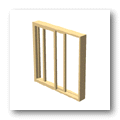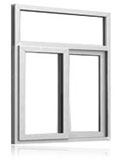Windows come in many shapes, sizes, and types, and made from variety of materials. How do you select the right ones? There are several criteria to consider – your budget, your home style, and how you want the window to perform. Think about the relative importance of ventilation and security, and how easy it should be to maintain and decide whether you want to emphasize the window as a focal point or have it served in a more practical manner.
There are two main types of windows: those that open and those that don’t. Those that open are called Operable and those that don’t are called Fixed. The illustration on these pages show the common varieties and will give you basic information about how they perform.

Fixed windows are stationary units mounted within a frame. They are great for letting in light and exposing views, but provide no ventilation. Among the more visually interesting choices are octagonal, half circle, ellipse windows and a corner window that has a single pane if bent at a 90 degree angle.
These windows tend to be more energy efficient as they quite simply don’t open and properly installed offer fewer opportunities for drafts.

Casement windows are hinged at the sides. Hinged windows such as casements generally have lower air leakage rates than sliding windows from the same manufacturer because the sash closes by pressing against the frame. Casement windows project outward, providing significantly better ventilation than sliders of equal size. Because the sash protrudes from the plane of the wall, it can be controlled to catch passing breezes, but screens must be placed on the interior side. Virtually the entire casement window area can be opened, while sliders are limited to less than half of the window area.

Awning windows are hinged at the top and open outward. Hinged windows such as awnings generally have lower air leakage rates than sliding windows from the same manufacturer because the sash closes by pressing against the frame. Screens are placed on the interior of the window unit. Similar to casements, the entire window area can be opened, while sliders are limited to less than half of the window area.

Hopper windows are hinged at the bottom and open inward. Hinged windows such as hoppers generally have lower air leakage rates than sliding windows from the same manufacturer because the sash closes by pressing against the frame. Screens are placed on the exterior of the window unit. Similar to casements, the entire window area can be opened, while sliders are limited to less than half of the window area.
 Slider:
Slider:Both sashes slide horizontally in a double-sliding window. Only one sash slides in a single-sliding window. A Vertical Slider or Single Hung window, as it is also known, is identical to a Horizontal Slider but the bottom slides up. Ventilation area can vary from a small crack to an opening of one-half the total glass area. Screens can be placed on the exterior or interior of the window unit. Horizontally sliding windows generally have higher air leakage rates than projecting or hinged windows.
 Combination Windows:
Combination Windows:Combination window is an integration of two windows of the same type (like casement-casement) or different types (casement-slider or fixed-slider).
UPVC Windows derive 95% of their strength from reinforcements made of galvanized steel. They are used in chambers of the profile to provide the necessary strength to the window members. Separate sealed chambers in profile and zinc coating on steel bestows longevity to the product during its usage period.The thickness and shape of the section is designed to provide the necessary functional and performance parameters of window. The usual thickness of steel reinforcement varries between 16 SWG 20 SWG.
The reinforcements are screwed to the UPVC profile at a designed pitch using self drilling special screws. The unification of the duo renders strength to the window.